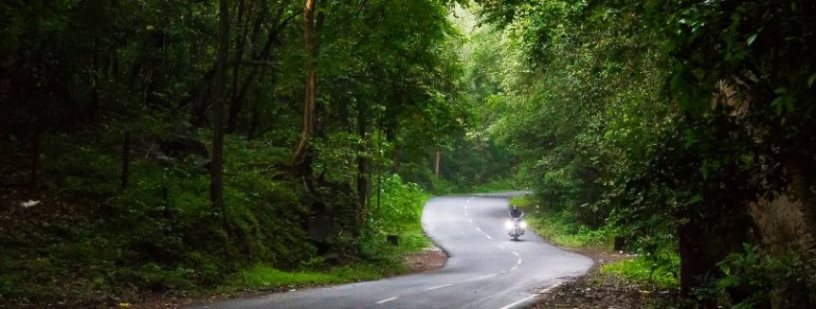The cool bracing wind whips the hair about your faces as you ramble along the streets that dip and rise delightfully. Breathtaking views surprise you from pretty cottages as you sniff appreciatively the heady fragrance of coffee blossoms. You are in Madikeri (previously known as Mercara). A picturesque charming town situated at an elevation of over 5,000 ft (1,525 m) above sea level.
Coorg also called as Kodagu is derived from the local version Kodavu and the people of Kodagu. According to ancient scripts the land of initial settlement was called Krodadesa which later became Kodavu.
Where is Coorg Located?
Coorg is located in the south-west part of Karnataka bordering Kerala. Coorg measures 96 km (north-south) in length and 64 km east-west in breadth. The area of Coorg district is 4102 sq. kilometers and the population estimated in 2001 was 545,322, increasing 11.64% from 1991 to 2001, and 5.75% from 1981 to 1991. Madikeri is the district headquarters of Coorg. Madikeri is only connected by road and is located at a distance of 240 kms from Bangalore, 120 kms from Mysore, 140 Kms from Mangalore, 115 Kms from kannur, Kerala.
Coorg in History
Coorg was under the Gangas rule during 9th and 10th centuries and Cholas in the 11th century. Changalvas were allies to both the above dynasties but they were independent till 14th century as Hoysalas defeated the Cholas in the 12th century. Changalvas accepted the supremacy Of Hoysalas from 14th to 16th century. Then Nayakas who later paved the way to the Haleri Rajas of Kodagu ruled Coorg till 1834.
Coorg Travel
Coorg is one of India’s famous travel destination and has been called the Scotland of India by the British and also called as the Kashmir of South India. Coorg has become a latest tourist hot spot and people from all over the world visit Coorg.
Coorg has been receiving a growing number of travellers consistently over the years and has been one of the sought after South Indian hill station. On the one hand, this has encouraged some of the best brands to set up accommodation facilities and has upped the overall destination experience quotient. On the other, the locals have made the experience even more interesting with excellent cultural, culinary and nature-engaging experiences that beckon repeat travellers. Home-stays in this region has been a unique experience to travellers. Travel Media across the world have repeatedly generated multiple articles and programs on this abode of verdant nature which is also a place with high historical significance.The prominent peaks in Coorg are Kote Betta, Pushpagiri, Nishani Motte, Tumbe Male. Tadiyandamol (1750 m), Soma Male and Brahmagiri.
Coorg’s natural beauty, the people, the culture and the food is the major attraction which draws people towards Coorg from all over the world.
The People of Coorg
The people of Coorg varies from Kodavas, the main ethnic group to communities like Are Bhase Gowda, Beary Muslims, Keralites and tribes like Yeravas, Kurubas, Airies and Kudiyas. The Kodava people, speaking Kodava takk and experts in martial arts, numbers about 1,00,000. A majority of Kodava people belong to Hindu religion and these Kodava Hindus are known as Kodava Kshathriyas. They are non vegetarians. But they consider eating beef as an unpardonable sin. Kudavas were land owners and Poleyas were the people worked for them. They worship deities like Bhagawathi (Parvathi, Saraswathi or Lakshmi), Mahadeva (Lord Shiva), Bhadarakali (Incarnation of Parvathi), Subrahmani (Lord Subrahmanya) and Lord Aiyappa. The important local God ‘Iggutappa’, an incarnation of Lord Subrahmanya, is the God of snakes, rain, harvest and rice.
The Muslims of Coorg are mainly Kodava Mappilas and Malabar Mappilas. Kodava Mappilas include the Beary Muslims and Shaikhs. Malabar Mappilas are Muslims emigrated from Malabar Coast who are traders and entrepreneurs now.
Cuisine
Boiled rice (koolu) and rice gruel (kanjee) formed the staple food of the Kodavas. The coconut, jackfruit, plantain, mango and other fruits and vegetables were widely used. Ghee was used in well-to-do families and on festive occasions. Rice in the form of Kanji or Koolu was served at meals along with curries and other additional dishes. Non-vegetarian food was not objectionable and alcoholic drinks as a rule weren't prohibited. Pork, chicken and river fish were commonly consumed as also were game meat occasionally but beef was prohibited due to Kodavas’ Hinduism. The wealthy owned large herds of milky cattle. Sweet dishes like akki payasa were prepared during festive occasions. Other special dishes included otti (rice roti), paaputtu (similar to idli), noolputtu (rice noodles), thambuttu (a sweet), etc
Madikeri is the district headquarters of Kodagu (formerly Coorg). Dubbed as the Scotland of India, Kodagu is the home of colorful, robust, martial race - the Kodavas, Said to be the descendants of the Greeks (Alexander's soldiers), the kodavas are fiercely independent. They were never conquered by either Tipu Sultan neither the British. And so to this day all kodavas retain the privilege of carrying firearms without a license.


